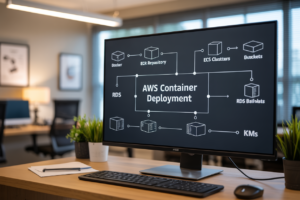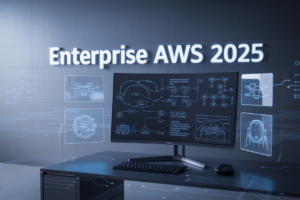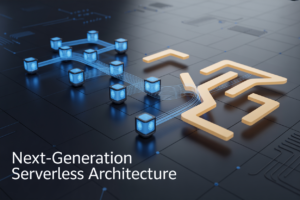🚀 Imagine a world where coding is as intuitive as having a conversation. Welcome to the era of “vibe coding” – a revolutionary approach that’s reshaping the landscape of software development. With AI giants like GPT-4, Copilot, and Cursor leading the charge, developers are now able to translate their ideas into code faster than ever before. But is this rapid evolution a double-edged sword?
As we stand on the precipice of this technological breakthrough, it’s crucial to understand both the incredible potential and the lurking dangers of fast-tracking development. Are we sacrificing quality for speed? Can AI truly capture the nuances of human creativity in coding? These questions are at the heart of the vibe coding phenomenon, challenging us to rethink the very essence of software creation.
In this deep dive, we’ll explore the ins and outs of vibe coding, from its game-changing benefits to its potential pitfalls. We’ll examine the key players shaping this new frontier, unpack the challenges that lie ahead, and ponder the delicate balance between innovation and reliability. So, fasten your seatbelts as we embark on a journey through the exciting, and sometimes perilous, world of vibe coding! 🖥️💡
Understanding Vibe Coding
A. Definition and concept
Vibe coding is an emerging approach to software development that leverages AI-powered tools to streamline and accelerate the coding process. It combines the developer’s intent and creativity with AI’s ability to generate, complete, and refine code snippets. This synergy allows programmers to focus more on high-level problem-solving and less on repetitive coding tasks.
B. How it differs from traditional coding
| Aspect | Traditional Coding | Vibe Coding |
|---|---|---|
| Code Generation | Manual typing | AI-assisted generation |
| Speed | Slower, more methodical | Faster, more intuitive |
| Focus | Syntax and implementation details | High-level logic and problem-solving |
| Learning Curve | Steeper for beginners | Potentially easier entry point |
| Customization | Full control over every line | Balance between AI suggestions and manual tweaks |
Vibe coding significantly reduces the time spent on boilerplate code and common programming patterns. Instead of writing everything from scratch, developers can describe their intent, and AI tools suggest or generate relevant code snippets. This shift allows for a more fluid and creative coding experience.
C. The role of AI in vibe coding
AI plays a central role in vibe coding by:
- Generating code based on natural language descriptions
- Autocompleting code snippets and suggesting next steps
- Refactoring and optimizing existing code
- Providing context-aware documentation and explanations
- Identifying potential bugs and security vulnerabilities
These AI capabilities enhance the developer’s productivity and creativity, allowing them to tackle complex problems more efficiently. As we explore the key players in vibe coding, we’ll see how different tools and platforms are shaping this revolutionary approach to software development.
Key Players in Vibe Coding
GPT-4: Capabilities and applications
GPT-4, the latest iteration of OpenAI’s language model, has revolutionized vibe coding with its advanced natural language processing capabilities. This AI powerhouse can generate, analyze, and modify code across various programming languages, making it a versatile tool for developers.
Key capabilities of GPT-4 in vibe coding:
- Code generation
- Bug detection and fixing
- Code optimization
- Natural language to code translation
- Documentation creation
| Application | Description |
|---|---|
| Rapid prototyping | Quickly generate code snippets for new features |
| Code refactoring | Suggest improvements to existing codebase |
| Learning tool | Explain complex code concepts to novice developers |
| Pair programming | Act as an AI coding partner for problem-solving |
GitHub Copilot: AI-assisted coding
GitHub Copilot, powered by OpenAI’s Codex, is a game-changer in the realm of vibe coding. This AI-powered coding assistant integrates seamlessly with popular IDEs, offering real-time code suggestions and autocompletions.
Benefits of GitHub Copilot:
- Increased coding speed
- Reduced boilerplate code
- Context-aware suggestions
- Support for multiple programming languages
Cursor: Enhancing developer productivity
Cursor, an AI-enhanced code editor, combines the power of GPT-4 with a user-friendly interface to boost developer productivity. Its innovative features streamline the coding process and facilitate faster problem-solving.
Key features of Cursor:
- AI-powered code completion
- Intelligent code refactoring
- Natural language code generation
- Contextual documentation lookup
Other emerging tools and platforms
The vibe coding landscape is rapidly evolving, with new AI-powered tools emerging to address specific development needs. Some noteworthy mentions include:
- TabNine: AI-powered code completion tool
- CodeWhisperer: Amazon’s machine learning-powered coding companion
- Replit Ghost Writer: AI coding assistant for collaborative development
As these tools continue to evolve, developers must stay informed about their capabilities and limitations to leverage them effectively in their workflow.
Benefits of Vibe Coding
Increased development speed
Vibe coding, powered by AI tools like GPT-4, Copilot, and Cursor, significantly accelerates the development process. Developers can now write code faster than ever before, with AI assistance providing instant suggestions and auto-completions. This speed boost allows teams to:
- Rapidly prototype new features
- Quickly iterate on existing code
- Meet tight deadlines with ease
- Reduce time-to-market for software products
Reduced cognitive load for developers
AI-assisted programming alleviates the mental strain on developers by:
- Handling repetitive coding tasks
- Suggesting optimal solutions for complex problems
- Providing context-aware code snippets
- Offering real-time documentation and explanations
This reduction in cognitive load allows developers to focus on higher-level problem-solving and creative aspects of software development.
Improved code quality and consistency
Vibe coding tools contribute to enhanced code quality and consistency through:
| Feature | Benefit |
|---|---|
| Code standardization | Ensures uniform coding style across projects |
| Best practice suggestions | Promotes industry-standard coding patterns |
| Automated error detection | Identifies and fixes common coding mistakes |
| Intelligent refactoring | Suggests improvements for cleaner, more efficient code |
Enhanced problem-solving capabilities
AI-powered vibe coding empowers developers with advanced problem-solving abilities:
- Access to vast knowledge bases for quick solution discovery
- Pattern recognition for identifying optimal algorithms
- Intelligent code analysis for performance optimization
- Contextual understanding of complex programming challenges
These benefits collectively transform the development landscape, enabling programmers to tackle more ambitious projects and push the boundaries of what’s possible in software engineering.
Potential Risks and Challenges
Over-reliance on AI-generated code
As vibe coding gains popularity, developers may become excessively dependent on AI-generated code. This over-reliance can lead to:
- Reduced critical thinking skills
- Difficulty in troubleshooting complex issues
- Decreased ability to write original code
| Pros of AI-generated code | Cons of over-reliance |
|---|---|
| Increased productivity | Skill atrophy |
| Faster development cycles | Reduced innovation |
| Consistent code quality | Limited problem-solving |
Decreased understanding of underlying principles
Vibe coding’s efficiency might come at the cost of comprehending fundamental programming concepts:
- Algorithmic thinking
- Data structures
- Design patterns
- System architecture
Developers may struggle to grasp these crucial elements, impacting their ability to create robust, scalable solutions.
Security and privacy concerns
AI-generated code may introduce unforeseen vulnerabilities:
- Potential for biased or insecure code snippets
- Risk of incorporating outdated or deprecated functions
- Difficulty in auditing AI-generated code for security flaws
Impact on junior developers’ learning curve
The widespread adoption of vibe coding tools could significantly affect how new programmers learn and develop their skills:
- Reduced hands-on coding experience
- Overreliance on AI suggestions
- Difficulty in understanding complex codebases
As we consider these potential risks and challenges, it’s crucial to explore ways to balance the benefits of vibe coding with maintaining high-quality development practices.
Balancing Speed and Quality in Development
Implementing proper code review processes
In the era of vibe coding and AI-assisted programming, maintaining a robust code review process is more crucial than ever. Here’s how to implement effective code reviews:
- Establish clear review criteria
- Use automated tools for initial checks
- Implement pair programming sessions
- Conduct regular team code reviews
| Review Type | Frequency | Participants | Focus Areas |
|---|---|---|---|
| Automated | Continuous | AI tools | Syntax, style, basic errors |
| Pair Programming | Daily | Two developers | Logic, design, efficiency |
| Team Review | Weekly | Entire team | Architecture, scalability, security |
Maintaining coding standards and best practices
While AI tools like GPT-4 and Copilot can generate code quickly, it’s essential to ensure that this code adheres to established standards:
- Document AI-generated code thoroughly
- Regularly update coding style guides
- Enforce consistent naming conventions
- Implement automated linting and formatting tools
Integrating human expertise with AI assistance
Balancing human intelligence with AI capabilities is key to successful vibe coding:
- Use AI for repetitive tasks and boilerplate code
- Rely on human expertise for complex logic and system design
- Implement AI-assisted code suggestions as a complement, not a replacement
- Encourage continuous learning to stay ahead of AI advancements
By striking this balance, developers can leverage the speed of AI-assisted coding while maintaining the quality and reliability that human expertise provides. As we move forward, it’s crucial to consider the ethical implications and potential risks associated with increased reliance on AI in software development.
Future of Vibe Coding
Predicted advancements in AI-assisted development
As AI technology continues to evolve, we can expect significant advancements in AI-assisted development. These improvements will likely include:
- Enhanced context understanding
- More accurate code suggestions
- Improved natural language processing
- Integration with version control systems
- Automated bug detection and fixing
| Advancement | Description |
|---|---|
| Context understanding | AI will better grasp project-specific requirements and coding styles |
| Code suggestions | More precise and tailored code recommendations based on developer preferences |
| Natural language processing | Improved ability to translate human language into functional code |
| Version control integration | Seamless collaboration between AI tools and version control systems |
| Bug detection and fixing | Automated identification and resolution of code issues in real-time |
Potential impact on software engineering roles
The rise of vibe coding and AI-assisted development will undoubtedly reshape software engineering roles. While some fear job displacement, it’s more likely that the nature of these roles will evolve:
- Shift towards higher-level problem-solving
- Increased focus on system architecture and design
- Greater emphasis on AI tool management and optimization
- Need for enhanced soft skills and interdisciplinary knowledge
- Emergence of new specializations in AI-human collaboration
Preparing for the evolving landscape of coding
To stay ahead in this rapidly changing field, developers and organizations should:
- Embrace continuous learning and upskilling
- Develop a deep understanding of AI tools and their limitations
- Foster creativity and critical thinking skills
- Cultivate adaptability and openness to new technologies
- Focus on areas where human expertise remains crucial, such as ethical considerations and complex problem-solving
As we look ahead, it’s clear that vibe coding and AI-assisted development will play an increasingly significant role in shaping the future of software engineering. The key to success will be finding the right balance between leveraging these powerful tools and maintaining human oversight and creativity.
Vibe Coding, powered by advanced AI tools like GPT-4, Copilot, and Cursor, is revolutionizing the software development landscape. This emerging approach promises to streamline coding processes, boost productivity, and democratize programming. However, as we embrace these innovations, it’s crucial to remain mindful of the potential risks and challenges that come with fast-tracking development.
As the future of Vibe Coding unfolds, striking a balance between speed and quality will be paramount. Developers and organizations must adopt a thoughtful approach, leveraging AI assistance while maintaining rigorous coding standards and practices. By doing so, we can harness the full potential of Vibe Coding to drive innovation and efficiency in software development, without compromising on the integrity and reliability of our digital solutions.




















